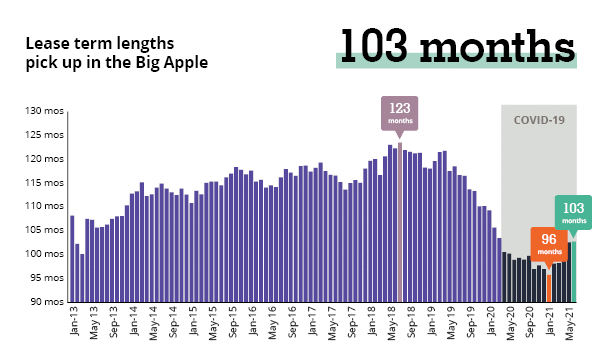The Data Bite: Longer Manhattan office term lengths are signaling a rebound


There is no end to the ways we can measure the economic impact of the pandemic. The earthquake that was COVID-19 shook every aspect of business, and office leasing was no exception. But there are clear signs of a rebound as companies navigate a return to the workplace.
One of the hallmark office markets in the world ---- New York City’s Manhattan --- offers a view into the fallout of the pandemic, and the road back. A ten-year period of sustained positive momentum came to a screeching halt in early 2020. Just before, unemployment rates in Manhattan reached a record low 2.8 percent in December 2019. Office tenants across industry segments pushed their way into massive, long-term commitments in some of the highest profile towers in the market.
For example, Facebook’s long-term lease for 1.2 million sf at 50 Hudson Yards or Deutsche Bank’s 1.1 million sf at 1 Columbus Circle were market leaders, along with a surge in flexible office space for professional and creative service firms. Looking at the 12-month moving average lease term length, the high point of 123 months was reached in late 2018 before it eventually fell off a pandemic-induced cliff.
As employers grappled with lockdowns and remote working protocols, uncertainty led to an embrace of short-term leases, particularly renewals. Lease term lengths decreased by 18.9% from 2018 to January 2021 and the proportionate share of renewals more than doubled from 18.1% from 2018 to March 2020 to 39.9% from April 2020 to now.
But there are signs of recovery, as reopening takes hold in New York City and across the country. Manhattan is still a reliable draw for talent and companies are seeking favorable lease terms as working life returns to previous patterns. One measure of the renewed confidence is the current average lease term length of 103 months, up from a low point of 96.8 months in January 2021.
Or looking at it another way, in just five months the Manhattan lease term lengths have added one-fourth of what was lost since the pandemic. The question facing landlords is whether demand continues to rise at this hopeful pace. Those with transit-oriented, high-quality properties are positioned to capitalize on this trend more than those offering less attractive space that must compete on pricing.
Snack-sized data and insights delivered weekly… and like any good snack, it’s both delightful and easy to digest. To get your fill delivered weekly in your inbox, sign up with our form.
